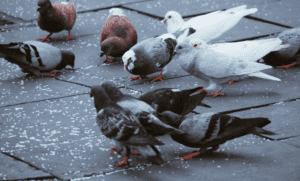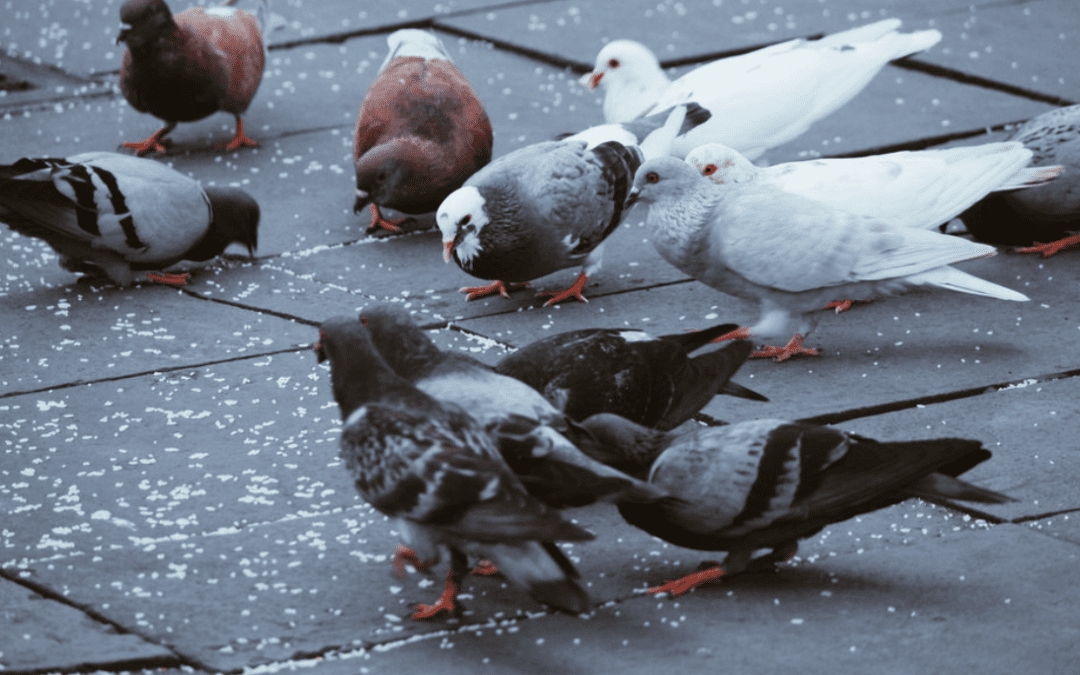Heading to his usual Sunday morning yoga class in Leslieville a few years ago, my husband, Peter, gave silent thanks when he found a sent-from-above parking spot right in front of the studio. He quickly eased his black Honda Fit, Jellybean, into the space and dashed to his class.
When Peter came out an hour and a half later, his car was so coated in poop he barely recognized it. “It looked like a bunch of elephants with wings had flown over my car and relieved themselves,” he said.
There were no pachyderms to be seen. Pigeons? Yes. Right above Jellybean a couple of hydro wires sagged under the weight of dozens of the city birds. There was only one thing to do. Peter drove straight to the old-timey car wash at Parliament and Front and paid the price to have the carapace of excrement removed. Twice.

Then there was the time our son’s girlfriend, Lisa, got pooped on at the bus stop at Lower Gerrard and Coxwell as she waited for her northbound bus to the subway. This stop is notorious for its pigeon problem and Lisa knew to be vigilant. But on this particular day she was running late for work, on her phone and not paying attention to the birds lined up like so many grey bombers in formation above her. When the bomb-bay doors opened, the blast hit her freshly washed hair. Thinking quickly, she dashed into one of the restaurants in Little India, washed the mess out and continued on her way.
Just another day trying to coexist peacefully with pigeons, the birds first dubbed “rats with wings” by New York City parks commissioner Thomas Hoving in 1966.
I didn’t think too much more about my family members’ run-ins with the tubby birds known officially as rock pigeons and formerly as rock doves. But a few weeks ago, our daughter, Em, mentioned that a family of pigeons had been hanging out on the peaked roof outside her bedroom window. That got my attention. In the more than 20 years we’ve lived here, none of us had ever seen a pigeon on any part of our roof.
Then a couple of nights ago, when I had my bedroom window open to allow the sweet-smelling evening breezes in, I heard faint noises that sounded like the scritch-scratch of bubble-gum pink feet moving about in our eavestroughs.
The next day, I decided to see if I could get a look at the pigeons. It turns out I didn’t need special clearance from MI6 to spy on them through Em’s window. Far from flying off in a furious flap of wings as I neared the glass, they were thoroughly unperturbed by my approach.
There were three pigeons, all about the same size. A close look revealed two were fledglings and the third was an adult. The youngsters skittered up and down our grey roof tiles, pursuing their parent for food. Once they made contact, they pushed their beaks into their parent’s bill, as if to say, “Come on! We know you’ve got our crop milk in there.” But the adult was having none of it; its parental contract for food delivery had already ended.
Until I started reading about the birds on our roof, I had taken the common pigeon, Columba livia, for granted. I thought of them as birds that had always been here, part of the everyday fabric of city life.
While it’s true rock pigeons have been associated with humans for many thousands of years, they haven’t always been in North America. They didn’t reach this continent until the early 1600s. Prior to this, rock pigeons were natural residents of Eurasia and North Africa, where their wild nests could be found in narrow crevices plentiful in sea cliffs, caves and canyons.
The latter fact explains why these birds have fared so well in both the New and Old Worlds. Wherever humans have created towns and cities, places with man-made structures that emulate cliffs, rock pigeons have found a home.
Beyond being evolutionarily successful, rock pigeons are beautiful birds with a regal carriage. Sure, they poop a lot. And it can be hazardous to park or walk under a flock of these birds on a wire. Step carefully, I say, and admire their shimmering, iridescent plumage.
And what of the birds on our roof? When I looked out Em’s window this morning, only the adult pigeon was there; the fledglings, rebuffed, had finally departed. A single small white feather remained on the tiles, a reminder of the pigeon family that was.
Pigeon Patrol Products & Services is the leading manufacturer and distributor or bird deterrent (control) products in Canada. Pigeon Patrol products have solved pest bird problems in industrial, commercial, and residential settings since 2000, by using safe and humane bird
deterrents with only bird and animal friendly solutions. At Pigeon Patrol, we manufacture and offer a variety of bird deterrents, ranging from Ultra-flex Bird Spikes with UV protection, Bird Netting, 4-S Bird Gel and the best Ultrasonic and audible sound devices on the market today.
Voted Best Canadian wholesaler for Bird Deterrent products ten years in a row.
Contact us at 1 877-4-NO-BIRD,(604) 585-9279 or visit our website at www.pigeonpatrol.ca
Pigeon/Pigeon Patrol / Pigeons Roosing / Vancouver Pigeon Control / Bird Spikes / Bird Control / Bird Deterrent / PIgeon Deterrent / Surrey Pigeon Control / Pest / Seagull deterrent / Vancouver Pigeon Blog / Birds Inside Home / Pigeons in the cities / Ice Pigeons / What to do about pigeons / sparrows, Damage by Sparrows, How to Keep Raccoons Away, Why Are Raccoons Considered Pests / De-fence / Pigeon Nesting / Bird Droppings / Pigeon Dropping / woodpecker control / Professional Bird Control Company / Keep The Birds Away / Birds/rats/seagull/pigeon/woodpecker/dove/sparrow/pidgeon control/pidgeon problem/pidgeon control/flying rats/pigeon problems/ bird netting/bird gel/bird spray/bird nails/bird guard

